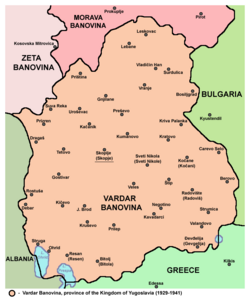Vardar bank
The Vardar Banschaft ( Vardarska banovina , Cyrillic Вардарска бановина ; German Banschaft Vardar ) was an administrative unit within the Kingdom of Yugoslavia from 1929 to 1941 . It comprised the entire area of what is now the Republic of North Macedonia and the southernmost parts of Serbia , including southern Kosovo . The administrative seat was Skopje . The entire state administrative apparatus was occupied by Serbs and Montenegrins.
history
The Banschaft Vardar was formed when King Alexander I, after his coup d'état in 1929, had Yugoslavia divided into 9 Banovine ( Banschafts ), most of which were named after rivers. The Vardar Banschaft got its name from the Vardar , the main river through which it flowed. After the establishment of the Croatian bank in 1939, the plan was to divide Yugoslavia into three federal units, consisting of the Slovenian, Croatian and Serbian banks. The Serbian bank should have included the banks of Vrbas , Drina , Zeta , Danube , Morava and Vardar, with Skopje as the capital. The Second World War prevented the implementation of the plan. After the war, the Republic of Macedonia was founded in communist Yugoslavia and formed as a federal republic, the northern areas became part of the Republic of Serbia. The Vardar bank was not renewed.
literature
- Ljubodrag Dimić: Serbia and Yugoslavia (1918–1941) . In: Österreichische Osthefte . 47, No. 1-4, 2005, pp. 231-264.
Web links
Individual evidence
- ^ Heinz Willemsen, Stefan Troebst: Schüttere continuities, multiple breaks; The Republic of Macedonia 1987–1995 . In: Egbert Jahn (Ed.): Nationalism in late and post-communist Europe . Volume 2: Nationalism in the Nation-States . Verlag Nomos, 2009, ISBN 978-3-8329-3921-2 , p. 517

